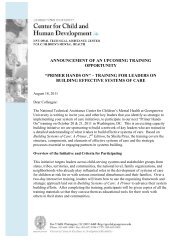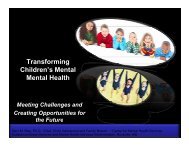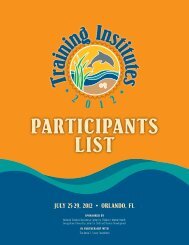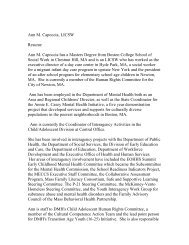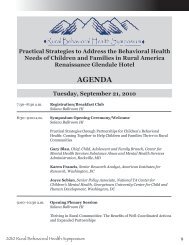Strengthening Families The Protective Factors Framework - National ...
Strengthening Families The Protective Factors Framework - National ...
Strengthening Families The Protective Factors Framework - National ...
Create successful ePaper yourself
Turn your PDF publications into a flip-book with our unique Google optimized e-Paper software.
What We Know: <strong>Families</strong><br />
thrive when protective<br />
factors are robust in their<br />
lives and communities.<br />
<strong>The</strong> <strong>Protective</strong> <strong>Factors</strong> <strong>Framework</strong><br />
Using the <strong>Strengthening</strong><br />
<strong>Families</strong> Approach, over thirty<br />
states are shifting policy,<br />
funding and training to help<br />
programs working with<br />
children and families<br />
build protective factors<br />
with families. Many states<br />
and counties also use<br />
the <strong>Protective</strong> <strong>Factors</strong><br />
<strong>Framework</strong> to align services<br />
for children and families,<br />
strengthen families in the<br />
child welfare system and<br />
work in partnership with<br />
families and communities<br />
to build protective factors.<br />
For more information and<br />
many tools and options for<br />
implementation, visit www.<br />
strengtheningfamilies.net<br />
<strong>National</strong>ly, <strong>Strengthening</strong><br />
<strong>Families</strong> is coordinated by<br />
the Center for the Study<br />
of Social Policy (CSSP) and<br />
supported by national partner<br />
organizations including:<br />
n Child Welfare Information<br />
Gateway<br />
n <strong>The</strong> Finance Project<br />
n FRIENDS <strong>National</strong> Resource<br />
Center<br />
n <strong>The</strong> <strong>National</strong> Alliance of<br />
Children’s Trust and<br />
Prevention Funds<br />
n Parents As Teachers<br />
n United Way Worldwide<br />
n ZERO TO THREE<br />
Five <strong>Protective</strong> <strong>Factors</strong> are the foundation of the <strong>Strengthening</strong> <strong>Families</strong> Approach: parental<br />
resilience, social connections, concrete support in times of need, knowledge of parenting<br />
and child development, and social and emotional competence of children. Research studies<br />
support the common-sense notion that when these <strong>Protective</strong> <strong>Factors</strong> are well established in a<br />
family, the likelihood of child abuse and neglect diminishes. Research shows that these protective<br />
factors are also “promotive” factors that build family strengths and a family environment<br />
that promotes optimal child and youth development.<br />
Parental Resilience<br />
No one can eliminate stress from parenting, but a parent’s capacity for resilience can affect<br />
how a parent deals with stress. Resilience is the ability to manage and bounce back from all<br />
types of challenges that emerge in every family’s life. It means finding ways to solve problems,<br />
building and sustaining trusting relationships including relationships with your own child, and<br />
knowing how to seek help when necessary.<br />
Social Connections<br />
Friends, family members, neighbors and community members provide emotional support,<br />
help solve problems, offer parenting advice and give concrete assistance to parents. Networks<br />
of support are essential to parents and also offer opportunities for people to “give back”, an<br />
important part of self- esteem as well as a benefit for the community. Isolated families may<br />
need extra help in reaching out to build positive relationships.<br />
Concrete Support in Times of Need<br />
Meeting basic economic needs like food, shelter, clothing and health care is essential for<br />
families to thrive. Likewise, when families encounter a crisis such as domestic violence, mental<br />
illness or substance abuse, adequate services and supports need to be in place to provide<br />
stability, treatment and help for family members to get through the crisis.<br />
Knowledge of Parenting and Child Development<br />
Accurate information about child development and appropriate expectations for children’s<br />
behavior at every age help parents see their children and youth in a positive light and promote<br />
their healthy development. Information can come from many sources, including family members<br />
as well as parent education classes and surfing the internet. Studies show information is most<br />
effective when it comes at the precise time parents need it to understand their own children.<br />
Parents who experienced harsh discipline or other negative childhood experiences may need<br />
extra help to change the parenting patterns they learned as children.<br />
Social and Emotional Competence of Children<br />
A child or youth’s ability to interact positively with others, self-regulate their behavior and effectively<br />
communicate their feelings has a positive impact on their relationships with their family,<br />
other adults, and peers. Challenging behaviors or delayed development create extra stress for<br />
families, so early identification and assistance for both parents and children can head off negative<br />
results and keep development on track.<br />
Center for the Study of Social Policy | 1575 Eye Street NW, Ste. 500 | Washington, DC 20010 | www.strengtheningfamilies.net | www.cssp.org
<strong>Strengthening</strong> <strong>Families</strong>: Creating a New Normal<br />
<strong>The</strong> <strong>Strengthening</strong> <strong>Families</strong> Approach:<br />
n<br />
n<br />
n<br />
n<br />
n<br />
Benefits ALL families<br />
Builds on family strengths, buffers risk, and promotes better outcomes<br />
Can be implemented through small but significant changes in everyday actions<br />
Builds on and can become a part of existing programs, strategies, systems and community opportunities<br />
Is grounded in research, practice and implementation knowledge<br />
Mobilizing partners, communities and families<br />
to build family strengths, promote optimal<br />
development and reduce child abuse and neglect<br />
Levers<br />
Strategies<br />
<strong>Protective</strong><br />
<strong>Factors</strong><br />
Results<br />
Community and<br />
multi-system leaders<br />
act to build sustainable<br />
infrastructure<br />
through key levers<br />
for change:<br />
• Parent<br />
Partnerships<br />
• Policy/Systems<br />
• Professional<br />
Development<br />
Community programs<br />
and worker practice<br />
consistently:<br />
• Facilitate friendships<br />
and mutual support<br />
• Strengthen parenting<br />
• Respond to family<br />
crises<br />
• Link families to<br />
services and<br />
opportunities<br />
• Value and<br />
support parents<br />
• Further children’s<br />
social and emotional<br />
development<br />
<strong>Families</strong> and<br />
communities build<br />
protective factors that<br />
also promote healthy<br />
outcomes:<br />
• Parental resilience<br />
• Social connections<br />
• Knowledge of<br />
parenting and<br />
child development<br />
• Concrete support<br />
in times of need<br />
• Social and<br />
emotional<br />
competence of<br />
children<br />
• Strengthened<br />
families<br />
• Optimal child<br />
development<br />
• Reduced child<br />
abuse & neglect<br />
• Observe and<br />
respond to early<br />
warning signs of<br />
abuse and neglect<br />
A New Normal<br />
<strong>Families</strong> and communities, service systems and organizations:<br />
• Focus on building protective and promotive factors to reduce risk and create optimal outcomes for<br />
children, youth and families<br />
• Recognize and support parents as decision makers and leaders<br />
• Value the culture and unique assets of each family<br />
• Are mutually responsible for better outcomes for children, youth and families



